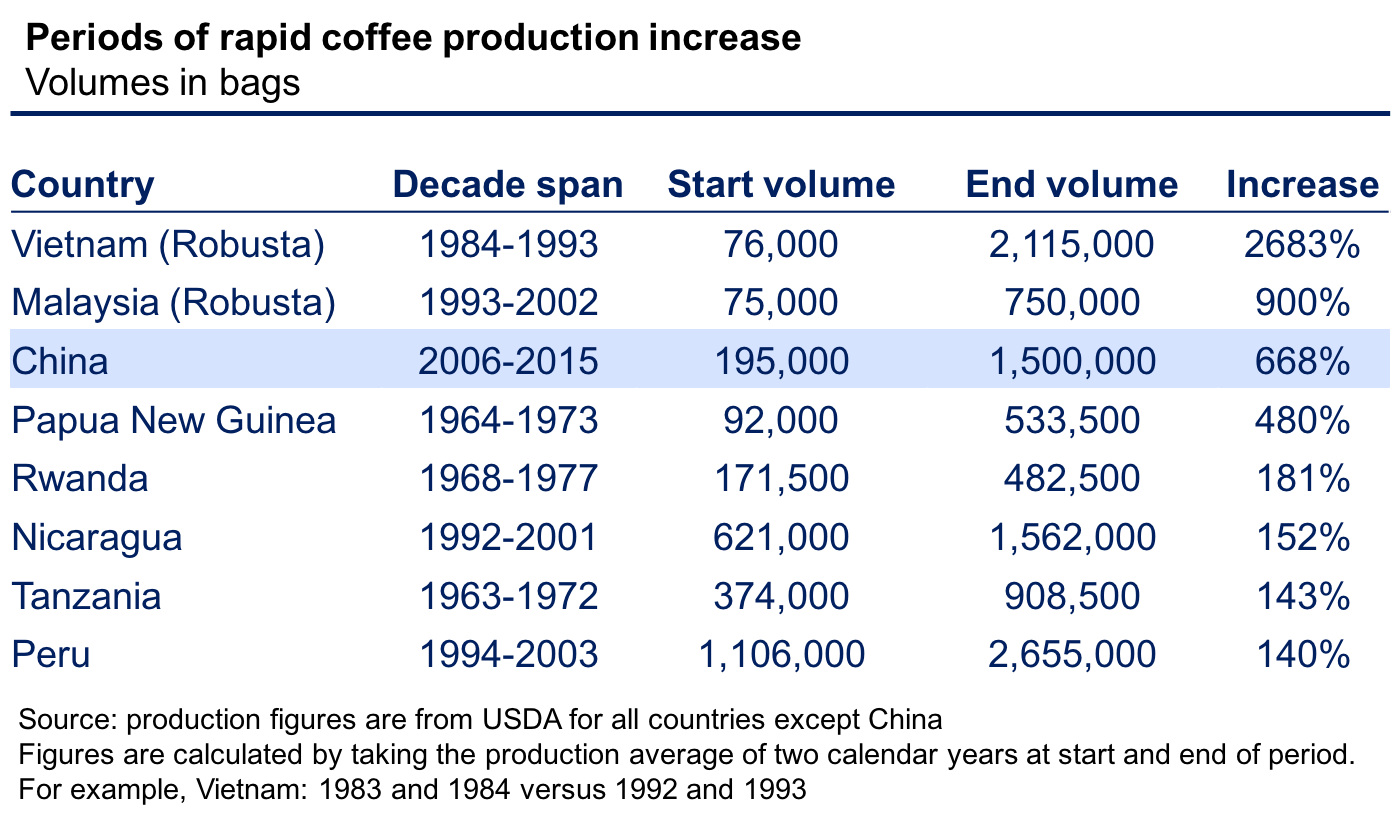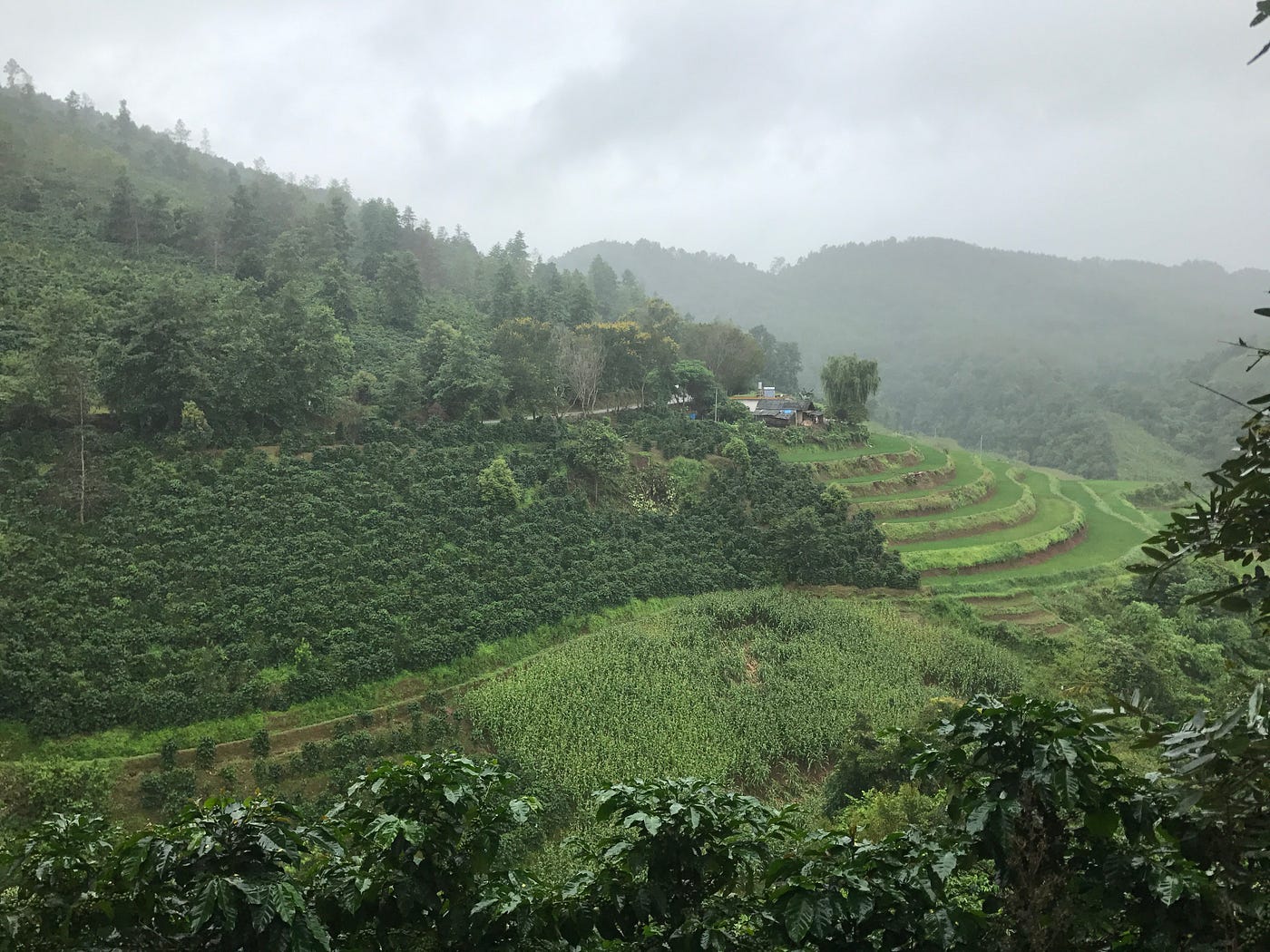Carl Cervone
Trip Report on China’s Coffee Sector
August 30, 2017
The goal of the trip was to learn how China’s coffee sector works and gather updated estimates on its size and scale. While the pace at which China has emerged as a major washed Arabica producer is unprecedented, I predict some speed bumps ahead.
China currently has the fastest-growing coffee industry in the world. In 2007, China produced around 13,000 tons. Today, the official total is 139,000 tons (2.3 million bags). Its year-over-year growth rate has exceeded 20% since 2007, which is reminiscent of Vietnam’s rapid rise during the 1990s. However, unlike Vietnam, over 99% of China’s production is Arabica. The Government of China has prioritized coffee planting in several prefectures (districts) of the country and has set a target of eventually reaching 4 million bags.
Nestlé played a large role in catalyzing China’s coffee industry. Nestlé began working in Pu’er, a prefecture in Yunnan Province better known for its tea, in 1988. It provided Catimor seedlings, trained farmers, and set quality standards for washed coffee. Today, Nestlé operates a manufacturing plant in Pu’er and directly sources about 10,500 tons of 4C-verified coffee from local growers. Other multinationals have entered the Yunnan market more recently, including Starbucks, as well as trading offices for Ecom, ED&F Man, and Louis Dreyfus. Multinational companies (including Nestlé) have about 40% market share, while wholly Chinese-owned exporters and roasters occupy the remaining 60%.
China’s official production figures should be viewed as directional, not exact. Interviews with the local private sector suggest the official estimate of 139,000 tons is a touch high. Our bottom-up estimates (described in the next section) give a total of around 90,000 tons. Experts commonly cited three reasons for why it is challenging to obtain reliable estimates of production.
· China is not an ICO member. The International Coffee Organisation (ICO) helps consolidate and harmonize industry statistics, including production and exports by country. Most producing countries have been ICO members for at least several decades. (The ICO was established in 1963.) The modern world of coffee does not have much experience with new entrants: the last Arabica producer to cross the one million bag threshold (and sustain it) was Honduras, in the late 1970s.
· Official estimates tend to be based on land area under coffee, not actual output. In other countries, we often see official totals that over-estimate the area of new coffee planted and under-estimate the area of coffee land converted to other crops. We aren’t sure if this is the case in China, but cash crop selection appears to be highly fluid. Many plots that used to have crops like sugarcane and corn were rapidly converted to coffee. Plots could also change back to other crops very quickly. These changes may not be captured if the official total only monitors new planting and not reductions of coffee trees.
· Because coffee trees take up to four years to mature, a large share of China’s coffee trees are still young and unproductive. It is not clear to what extent official production estimates have been discounted to account for immature trees.

Yunnan has four main coffee growing prefectures: Pu’er, Baoshan, Dehong and Lincang. We estimate that these prefectures contribute over 90% of Yunnan’s total production. Our estimates are derived from official tables published in 2010 and 2012, corroborated with stakeholder interviews and field visits in August 2017.
· Pu’er, the largest area, produces between 50–60,000 tons per year. While growth appears to have plateaued in some parts of Pu’er, there is still significant expansion around the town of Menglian, close to the border with Myanmar. Menglian has good quality potential with altitudes of up to 1650 meters. The company Yunnan Coffee Traders is working here and experimenting with new varietals and processing methods (e.g., naturals, honey-method).
· Baoshan was the first region in the country to grow coffee. Recently, coffee has become less competitive here relative to other crops (e.g., mango, durian). Production is reported to have dropped from a peak of 14,000 tons in 2010 to current estimates of around 8,000 tons.
· Dehong is another major producing area with a steady 15,000 tons annually. It is the home of the Dehong Hogood Company, China’s largest local roaster. Hogood manages most of the coffee grown in the area under rental agreements with smallholders.
· Lincang is a fast-growing production area. Production has risen from a base of just 500 tons in 2010 to an estimated 6,000 tons in 2016. The Lincang Lingfeng Coffee Industry Development Company is the leading player here. They operate 27 wet mills and manage more than 15,000 hectares of coffee. Most of the coffee in Lincang is newly planted. Several experts expect production from here to surpass 12,000 tons in the next two years.
Smallholders produce more than 80% of China’s coffee. The typical farmer grows coffee on just 3–5 “mu” (a mu is a local unit of area equivalent to 1/15 of a hectare). Smallholders cultivate coffee as a monoculture, separate from food crops. Macadamia and bananas may be used for shade, although most coffee in China is full-sun. Chinese smallholders are opportunistic and will quickly switch between coffee and other crops if the economic potential changes. There are also several large coffee plantations in China that have land holdings exceeding 6,000 mu (400 hectares). Most coffee plantations started by converting land from other crops or consolidating land from smallholders rather than clearing land that was previously unfarmed. The distinction between land owned by plantation companies and land contracted from smallholders by plantation companies is not always clear. However, we estimate the plantation sector to occupy approximately 10,000 hectares of planted coffee (not all mature).
 Coffee is grown on small plots, alongside rice, tea, sugarcane, corn, and other crops
Coffee is grown on small plots, alongside rice, tea, sugarcane, corn, and other crops
China has a unique land use system that mixes aspects of communal and individual management. Traditionally, rural land was owned by village collectives and contracted out in the form of long-term leases to individual households (members of the village). It recently became possible for farmers to further subcontract their land rights to individuals or private companies. In some cases, the village collective leases out a consolidated tract of land and the village members earn a cash payout without having to farm or physically remain in the village. In other cases, the farmers remain on the land, provide labor, and “sell” the product to the lessee. This second arrangement appears common in the coffee sector, with companies or large farmers leasing land from smallholders, providing coffee seedlings and fertilizer, and then “buying” cherry at a fixed price under an exclusive contract. The company has recourse with the village collective if the farmer is not productive or attempts to side-sell. We estimate that just over a third of China’s coffee area is managed under such arrangements, versus 30% of rural land country-wide.
Chinese farmers have high yields. The average yield across Yunnan is estimated at 1.2 tons of green coffee per hectare. Looking at mature coffee only, the average is closer to 1.8 tons per hectare. This makes China one of the highest yielding Arabica producers in the world — on par with Brazil and ahead of Costa Rica and Colombia. Nearly all of China’s coffee is Catimor, planted at high density (i.e., 5000 trees per hectare). Chinese farmers do not face major pest or disease problems. Fertilizer is applied in large quantities, typically over 1 ton per hectare per year. Irrigation is not commonly practiced.
China occupies a unique cost position in the market. It is not a low-cost country: agricultural wages are around 100 RMB per day (approx. $15), on par with Brazil but without the labor efficiencies achieved through mechanization or mechanical harvesting. Although China produces washed coffee with similar wet-milling set-ups as Colombia or Costa Rica, it receives a significant discount to the C market of around 15 to 20 cents per pound. We estimate a total cost of production between $1.00 to $1.10 per pound for plantations and contract farms (of which ~80% goes towards labor). For smallholders utilizing family labor, however, the cash cost of production is likely below $0.25 per pound, with an annual margin of around $3400 per hectare at current prices (modeled against a C price of $1.50). While this may seem like an attractive margin, farmers can earn slightly more “working” on their farms through contract arrangements in which they are paid 2 RMB per kg cherry harvested (equivalent to $0.88 per pound green). The companies engaged in large-scale rental agreements typically have backing from the Chinese government and low financing costs. As long as these economics remain, we should expect to see an increasing share of farms operating under contract arrangements.
While the government’s goal of 4 million bags seems attainable, there are limits on China’s growth potential. For one, the quantity of suitable land for Arabica is relatively small and already intensely cultivated with other high-value crops (including tea). Increasing labor and opportunity costs may throttle growth, as seen in older growing areas like Baoshan and Pu’er where production has already leveled off. If the C market falls well below $1.25 per pound, it seems probable that many Chinese farmers would convert their land to other crops. On the other hand, China is looking to improve quality and targeting the market share of washed Arabica producers like Honduras and Peru. Achieving a 5 to 10 cents higher differential would greatly improve the economics of coffee in China. China could also make moves to lower its cost structure, for example through mechanical harvesting.
Domestic consumption is growing at a rate of 15–20%. Starbucks, the leading retail chain in China, announced a goal of expanding from 2,800 to more than 5,000 stores by 2021. The big driver of domestic consumption, however, is instant coffee. Euromonitor estimates that 98% of the Chinese market is instant coffee. China currently imports nearly as much coffee as it produces; roughly half of imports are Vietnamese Robusta. Even though domestic consumption is growing at double-digit levels, the practice of importing Robusta from neighboring countries and exporting Chinese-grown Arabica should persist for another decade at least. (China currently exports at least 70% of its Arabica production.) Rising production, rising quality, and rising consumption are all reasons to keep a close eye on China.